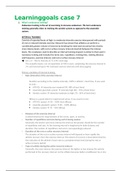Samenvatting
Summary Learning goals case 7
- Instelling
- Maastricht University (UM)
Whole case complete! Also exam questions are mentioned in the case. Thereby, also added notes during the turtorial written in red. I scored an 8 for this course.
[Meer zien]



